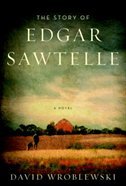A review of The Story of Edgar Sawtelle by David Wroblewski

There has been a lot of hype around this debut novel by David Wroblewski, with comparisons to the classic American writers of the mid 1900s, and suggestions of the emergence of a new Steinbeck. Unfortunately, the excessive praise showered upon this work create unreasonable expectations that are ultimately not met.
The story centers around a young mute named Edgar Sawtelle. The family business is the “Sawtelle dogs,” bred not for physical featues but for emotional attributes. In particular, a dog named Almondine develops an unique relationship with young Edgar, and the empathy between these two kindred souls is movingly described. The difficult but rewarding family life of Edgar, his parents Gar and Trudy, and the Sawtelle dogs is shattered by the return of Gar’s brother Claude. Soon after Claude’s return, a series of tragedies causes Edgar to go into exile. He manages to subsist in the wilderness with a trio of Sawtelle dogs, but is ultimately compelled towards a tragic homecoming.
There has been much criticism of the parallels to Hamlet. I didn’t mind this so much, as I firmly believe that re-interpretation of classical literature and mythology can result in magnificent work (for example, Eugene O’Neil’s Mourning Becomes Electra). However, this re-interpretation is feels forced and too adherent in many ways, leaving readers familiar with the Hamlet story without a sense of forward momentum. However, Wroblewski succeeds in many places with his magnificent use of imagery – when it works, it works beautifully, as shown in the following passage where owners of Sawtelle dogs and their dogs are described attending a burial.
A man leading a dog. It was Art Granger and Yonder, both limping with arthritis. Then Mr and Mrs McCullough, with Haze, the third Sawtelle dog their family had owned. Then Mrs. Santone, with Dreary. Then a lone woman with her dog, a curve of slack on its leash. A young couple with a boy and their dog. The dog’s exhalations plumed whitely over their heads as they came down the field. For a long time people kept appearing at the top of the path… and [Claude] directed them all down the path until the last of them had passed and they all stood in long arced rows around the birches.
There are many passages in this book that incur a strong debt to magic realism, both in good and bad ways. There is also an excessive attention to detail that is sometimes fascinating, but often just distracts from the narrative.
Overall, I felt that this book required a stronger editor. It is too long by at least 200 pages, and the prose has a tendency at places (particularly early on) to be bogged down by too much detail and excessive use of metaphors. Nevertheless, Wroblewski is a fine writer, and this is a good, if not great, first novel. In particular, if you are a canine aficionado or have a strong interest in dogs and dog breeding, this novel may provide a great deal of intellectual stimulation. However, readers should be sceptical about all the hype – this is not Steinbeck, not yet.